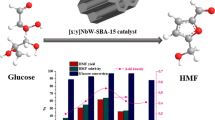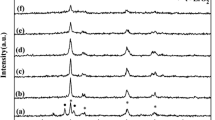Abstract
The control of acidic properties of a heterogeneous catalyst is one of the key features of biomass utilization technology for the production of chemical feedstock. In this study, Brønsted (B) and Lewis (L) acidic silica–zirconia (SZ) catalysts with controllable acidity were prepared using a simple hydrothermal method with a Si/(Si + Zr) molar ratio of 0.0–1.0, characterized by IR spectroscopy with adsorbed pyridine, and subsequently applied for the cascade conversion of glucose to 5-hydroxymethylfurfural (5-HMF). The Brønsted acidity of the SZ catalysts increased proportionally with the concentration of silica in the catalyst. The optimum ratio of B/(B + L) was investigated to maximize the yield of 5-HMF, which is converted from the glucose via fructose by a cascade reaction. Both the glucose conversion and selectivity to 5-HMF reached their maxima at a B/(B + L) ratio of 0.4, which showed a typical volcano relationship.
Graphical abstract







Similar content being viewed by others
References
Bozell JJ, Petersen GR (2010) Technology development for the production of biobased products from biorefinery carbohydrates—the US Department of Energy’s “Top 10” revisited. Green Chem 12:539–554
Chatterjee C, Pong F, Sen A (2015) Chemical conversion pathways for carbohydrates. Green Chem 17:40–71
Wei W, Wu S (2018) Experimental and kinetic study of glucose conversion to levulinic acid in aqueous medium over Cr/HZSM-5 catalyst. Fuel 225:311–321
Esteban J, Yustos P, Ladero M (2018) Catalytic processes from biomass-derived hexoses and pentoses: A recent literature overview. Catalysts 8:637
Takagaki A (2019) Rational design of metal oxide solid acids for sugar conversion. Catalysts 9:907
Ji J, Xu Y, Liu Y, Zhang Y (2020) A nanosheet Ru/WO3 catalyst for efficient conversion of glucose to butanediol. Catal Commun 144:106074
Shi N, Liu Q, Zhang Q, Wang T, Ma L (2013) High yield production of 5-hydroxymethylfurfural from cellulose by high concentration of sulfates in biphasic system. Green Chem 15:1967–1974
Sajid M, Zhao X, Liu D (2018) Production of 2,5-furandicarboxylic acid (FDCA) from 5-hydroxymethylfurfural (HMF): Recent progress focusing on the chemical-catalytic routes. Green Chem 20:5427–5453
Swift TD, Nguyen H, Erdman Z, Kruger JS, Nikolakis V, Vlachos DG (2016) Tandem Lewis acid/Bronsted acid-catalyzed conversion of carbohydrates to 5-hydroxymethylfurfural using zeolite beta. J Catal 333:149–161
Xue Z, Ma M-G, Li Z, Mu T (2016) Advances in the conversion of glucose and cellulose to 5-hydroxymethylfurfural over heterogeneous catalysts. RSC Adv 6:98874–98892
Otomo R, Tatsumi T, Yokoi T (2015) Beta zeolite: a universally applicable catalyst for the conversion of various types of saccharides into furfurals. Catal Sci Technol 5:4001–4007
Otomo R, Yokoi T, Tatsumi T (2015) OSDA-free zeolite beta with high aluminum content efficiently catalyzes a tandem reaction for conversion of glucose to 5-hydroxymethylfurfural. ChemCatChem 7:4180–4187
Hu L, Wu Z, Xu J, Sun Y, Lin L, Liu S (2014) Zeolite-promoted transformation of glucose into 5-hydroxymethylfurfural in ionic liquid. Chem Eng J 244:137–144
Chung NH, Oanh VT, Thoa LK, Hoang PH (2020) Catalytic conversion of glucose into 5-hydroxymethyl furfural over Cu-Cr/ZSM-5 zeolite. Catal Lett 150:170–177
Moliner M, Román-Leshkov Y, Davis ME (2010) Tin-containing zeolites are highly active catalysts for the isomerization of glucose in water. Proc Natl Acad Sci 107:6164–6168
Bermejo-Deval R, Gounder R, Davis ME (2012) Framework and extraframework tin sites in zeolite beta react glucose differently. ACS Catal 2:2705–2713
An H, Kweon S, Kang D-C, Shin C-H, Kim JF, Park MB, Min H-K (2021) Cascade conversion of glucose to 5-hydroxymethylfurfural over Brönsted-Lewis bi-acidic SnAl-beta zeolites. Korean J Chem Eng 38:1161–1169
Xu Q, Zhu Z, Tian Y, Deng J, Shi J, Fu Y (2014) Sn-MCM-41 as efficient catalyst for the conversion of glucose into 5-hydroxymethylfurfural in ionic liquids. BioResources 9:303–315
Zhang W, Zhu Y, Xu H, Gaborieau M, Huang J, Jiang Y (2020) Glucose conversion to 5-hydroxymethylfurfural on zirconia: tuning surface sites by calcination temperatures. Catal Today 351:133–140
Tanabe K, Yamaguchi T (1994) Acid-base bifunctional catalysis by ZrO2 and its mixed oxides. Catal Today 20:185–197
Yamaguchi T (1994) Application of ZrO2 as a catalyst and a catalyst support. Catal Today 20:199–217
Sato K, Horiguchi K, Nishikawa T, Yagishita S, Kuruma K, Murakami T, Abe H (2015) Hydrothermal synthesis of yttria-stabilized zirconia nanocrystals with controlled yttria content. Inorg Chem 54:7976–7984
Zarkov A, Stanulis A, Sakaliuniene J, Butkute S, Abakeviciene B, Salkus T, Tautkus S, Orliukas AF, Tamulevicius S, Kareiva A (2015) On the synthesis of yttria-stabilized zirconia: A comparative study. J Sol-Gel Sci Technol 76:309–319
Tsampas MN, Sapountzi FM, Vernoux P (2015) Applications of yttria stabilized zirconia (YSZ) in catalysis. Catal Sci Technol 5:4884–4900
Shevlev SA, Luchnikov PA, Yarullina AR (2016) Synthesis and characterization of yttria-stabilized zirconia (YSZ) nano-clusters for thermal barrier coatings (TBCs) applications. J Clust Sci 27:1097–1107
Klimova T, Rojas ML, Castillo P, Cuevas R, Ramírez J (1998) Characterization of Al2O3-ZrO2 mixed oxide catalytic supports prepared by the sol-gel method. Microporous Mesoporous Mater 20:293–306
Leitenburg C, Trovarelli A, Zamar F, Maschio S, Dolcetti G, Llorca J (1995) A novel and simple route to catalysts with a high oxygen storage capacity: the direct room-temperature synthesis of CeO2–ZrO2 solid solutions. J Chem Soc Chem Commun:2181–2182.
Fărcaşiu D, Li JQ, Cameron S (1997) Preparation of sulfated zirconia catalysts with improved control of sulfur content II. Effect of sulfur content on physical properties and catalytic activity. Appl Catal A: Gen 154:173–184
Yan H, Yang Y, Tong D, Xiang X, Hu C (2009) Catalytic conversion of glucose to 5-hydroxymethylfurfural over SO42−/ZrO2 and SO42−/ZrO2–Al2O3 solid acid catalysts. Catal Commun 10:1558–1563
Zhang X, Zhang Q, Wang T, Ma L, Yu Y, Chen L (2013) Hydrodeoxygenation of lignin-derived phenolic compounds to hydrocarbons over Ni/SiO2-ZrO2 catalysts. Bioresour Technol 134:73–80
Zhang X, Wang T, Ma L, Zhang Q, Huang X, Yu Y (2013) Production of cyclohexane from lignin degradation compounds over Ni/ZrO2-SiO2 catalysts. Appl Energy 112:533–538
Pyen S, Hong E, Shin M, Suh Y-W, Shin C-H (2018) Acidity of co-precipitated SiO2-ZrO2 mixed oxides in the acid-catalyzed dehydration of iso-propanol and formic acid. Mol Catal 448:71–77
Emeis CA (1993) Determination of integrated molar extinction coefficients for infrared absorption bands of pyridine adsorbed on solid acid catalysts. J Catal 141:347–354
Kim Y, Mittal A, Robichaud DJ, Pilath HM, Etz BD, St. John PC, Johnson DK, Kim S (2020) Prediction of hydroxymethylfurfural yield in glucose conversion through investigation of Lewis acid and organic solvent effects. ACS Catal 10:14707–14721
Chevalier J, Gremillard L, Virkar AV, Clarke DR (2009) The tetragonal-monoclinic transformation in zirconia: Lessons learned and future trends. J Am Ceram Soc 92:1901–1920
Andrianainarivelo M, Corriu R, Leclercq D, Mutin H, Vioux A (1996) Mixed oxides SiO2–ZrO2 and SiO2–TiO2 by a non-hydrolytic sol–gel route. J Mater Chem 6:1665–1671
Monte FD, Larsen W, Mackenzie JD (2000) Chemical interactions promoting the ZrO2 tetragonal stabilization in ZrO2–SiO2 binary oxides. J Am Ceram Soc 83:1506–1512
Rhodes M-D, Bell A-T (2005) The effects of zirconia morphology on methanol synthesis from CO and H2 over Cu/ZrO2 catalysts Part I. Steady-state studies. J Catal 233:198–209
Deng J, Liu J, Song W, Zhao Z, Zhao L, Zheng H, Lee AC, Chen Y, Liu J (2017) Selective catalytic reduction of NO with NH3 over Mo–Fe/beta catalysts: The effect of Mo loading amounts. RSC Adv 7:7130–7139
Kozo T, Takashi S, Katsue S, Tadamitsu K, Jun K (1974) A new hypothesis regarding the surface acidity of binary metal oxides. Bull Chem Soc Jpn 47:1064–1066
Assary RS, Redfern PC, Hannond JR, Greeley J, Curtiss LA (2010) Computational studies of the thermochemistry for conversion of glucose to levulinic acid. J Phys Chem B 114:9002–9009
Tsilomelekis G, Josephson TR, Nikolakis V, Caratzoulas S (2014) Origin of 5-hydroxymethylfurfural stability in water/dimethyl sulfoxide mixtures. Chemsuschem 7:117–126
Funding
This work was supported by the Incheon National University Research Grant in 2019 and C1 Gas Refinery Program through the National Research Foundation of Korea (NRF) funded by the Ministry of Science, ICT and Future Planning (2020M3D3A1A01028913).
Author information
Authors and Affiliations
Corresponding authors
Ethics declarations
Competing interests
The authors declare no competing interests.
Additional information
Publisher's note
Springer Nature remains neutral with regard to jurisdictional claims in published maps and institutional affiliations.
Supplementary Information
Below is the link to the electronic supplementary material.
Rights and permissions
About this article
Cite this article
An, H., Kim, Y.W., Kweon, S. et al. Cascade conversion of glucose to 5-hydroxymethylfurfural over Brønsted–Lewis bi-acidic SiO2–ZrO2 catalysts. Biomass Conv. Bioref. 13, 11779–11787 (2023). https://doi.org/10.1007/s13399-021-01978-w
Received:
Revised:
Accepted:
Published:
Issue Date:
DOI: https://doi.org/10.1007/s13399-021-01978-w




